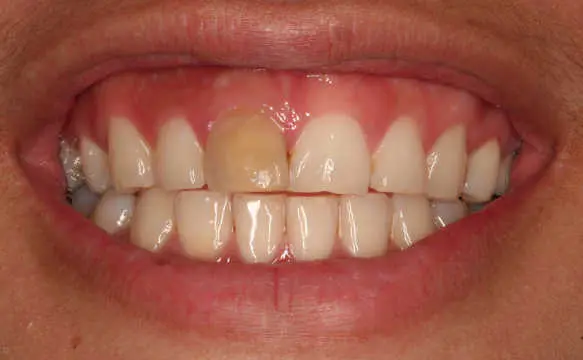A bright, white smile is often associated with health, confidence, and youth. So when teeth become stained or yellowed, it can feel frustrating and even embarrassing. But the truth is, tooth discoloration is incredibly common and can result from a range of causes—some within our control and others not. If you’ve ever wondered why your teeth look less than pearly white and what you can do about it, you’re not alone.
This comprehensive guide breaks down the most common causes of tooth discoloration and explores treatment options, including preventive steps and the role of cosmetic dentistry in restoring your smile.
The Two Main Types of Tooth Discoloration
To understand how to treat stained teeth, it’s essential to know the type of discoloration you’re dealing with. Dentists typically categorize discoloration into two groups:
1. Extrinsic Discoloration
This form of staining affects the outer enamel layer of the teeth. It’s most often caused by lifestyle factors such as consuming staining foods and beverages or using tobacco. Because it affects only the surface, extrinsic discoloration is usually the easiest to treat.
2. Intrinsic Discoloration
Intrinsic stains originate from within the tooth. These can be the result of trauma, certain medications, excessive fluoride, or health conditions that affect tooth development. Intrinsic stains are often more challenging to treat and may require professional intervention.
Understanding the source of the discoloration helps determine which treatments are most effective.
Common Causes of Tooth Discoloration
Tooth stains can result from a variety of factors. Some are environmental and behavioral, while others are biological or medical. Here’s a breakdown:
Diet and Lifestyle
- Coffee, Tea, and Red Wine: These beverages contain tannins, which can cling to enamel and darken teeth over time.
- Cola and Sports Drinks: The high acid content can erode enamel, making teeth more prone to stains.
- Tobacco Use: Both smoking and chewing tobacco introduce nicotine and tar, substances that leave persistent brown or yellow stains.
- Certain Foods: Berries, curry, soy sauce, and tomato-based sauces can also contribute to extrinsic discoloration.
Poor Oral Hygiene
Inadequate brushing and flossing allow plaque and food particles to build up, dulling the natural color of your teeth. Over time, this can lead to persistent stains and other dental issues like gum disease and decay.
Age and Enamel Erosion
As we age, the enamel on our teeth gradually wears away, revealing the naturally yellower dentin underneath. This is a normal part of aging, but it can be exacerbated by other factors such as acidic foods, teeth grinding, or over-brushing.
Medications and Medical Conditions
- Antibiotics: Tetracycline and doxycycline can cause intrinsic discoloration, especially when used in children whose teeth are still developing.
- Antihistamines and Antipsychotics: Some medications can result in a gray or brown tint.
- Cancer Treatments: Radiation and chemotherapy, particularly in the head and neck region, can alter tooth color.
- Health Conditions: Certain metabolic or genetic disorders can affect enamel and dentin development, resulting in discoloration.
Trauma or Injury
A hit to a tooth can cause it to darken over time. This happens when the pulp inside the tooth is damaged, often leading to internal bleeding that stains the dentin.
Fluorosis
Excessive fluoride during the development of teeth can lead to fluorosis, which presents as white spots or streaks on the teeth. In severe cases, the spots may become brown.
How to Prevent Tooth Discoloration
While not all causes of discoloration are preventable, many are. Here are some proactive steps you can take to keep your smile brighter for longer:
- Practice Good Oral Hygiene: Brush at least twice a day with fluoride toothpaste and floss daily to remove food particles and plaque.
- Limit Staining Foods and Drinks: Consider using a straw for drinks like coffee or tea and rinse your mouth with water afterward.
- Quit Smoking: Eliminating tobacco not only improves your oral health but also reduces staining significantly.
- Regular Dental Cleanings: Professional cleanings can remove surface stains that regular brushing may miss.
- Use Whitening Toothpaste: Some toothpastes are formulated with mild abrasives or chemical agents that help reduce surface stains.
Treatment Options for Discolored Teeth
When prevention isn’t enough, there are a variety of treatments available, ranging from over-the-counter solutions to advanced professional procedures. The best approach depends on the type and severity of the discoloration.
Whitening Toothpaste and Rinses
These are typically the first line of defense for extrinsic stains. They work by removing surface stains through mild abrasives and chemical agents. However, their effect is limited and usually takes several weeks of consistent use to become noticeable.
At-Home Whitening Kits
Over-the-counter kits use peroxide-based gels and trays to bleach the enamel. These can be effective for mild to moderate stains but may cause tooth sensitivity or gum irritation if used incorrectly.
In-Office Whitening Treatments
Professional whitening performed by a dentist delivers faster, more dramatic results. Using high-concentration bleaching agents and sometimes specialized lights or lasers, in-office treatments can brighten teeth by several shades in a single visit.
Dental Bonding
For stains that do not respond well to whitening, bonding involves applying a tooth-colored resin to the surface of the tooth. It’s an effective and relatively inexpensive way to cover up discoloration.
Veneers
Porcelain veneers are thin shells that cover the front of the teeth, offering a complete transformation for deeply stained or misshapen teeth. Veneers are durable and stain-resistant, making them a popular option in cosmetic dentistry.
Crowns
In cases where discoloration is combined with structural damage or decay, crowns can be used to both protect the tooth and improve its appearance. They cover the entire tooth and are custom-made for a natural look.
When to See a Dentist
While some discoloration is cosmetic, other times it could signal a deeper issue such as tooth trauma, decay, or an underlying health condition. You should consider seeing a dentist if:
- Your teeth suddenly change color without an obvious cause.
- You experience pain, sensitivity, or swelling in conjunction with discoloration.
- Over-the-counter whitening methods haven’t been effective.
A dental professional can provide a proper diagnosis and help you explore the most effective treatment options.
Conclusion
Tooth discoloration can stem from a wide array of sources, from daily habits to medical conditions. While some causes are purely aesthetic, others can be indicators of more serious issues. Fortunately, a combination of preventive care and modern treatment options offers numerous pathways to a brighter, healthier smile.
By understanding the root causes of staining and the available solutions—from whitening toothpaste to advanced cosmetic procedures—you can make informed decisions about your oral health. Whether you’re dealing with surface stains or deeper discoloration, cosmetic dentistry provides an array of tools to restore the appearance and confidence that come with a radiant smile.
Also Read-Revolutionizing Digital Content with AI Video Face Swap Technology


